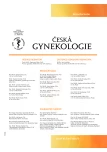Bilateral salpigektomy as a sterilization method – ovarian cancer prevetion and a rare complication
Authors:
L. Hloušková 1; R. Hudeček 2; J. Eim 1
Authors‘ workplace:
Gynekologicko‑porodnické oddělení Nemocnice, Vyškov, primář MUDr. J. Eim
1; Gynekologicko‑porodnická klinika LF MU a FN, Brno, přednosta doc. MUDr. V. Weinberger, Ph. D.
2
Published in:
Ceska Gynekol 2020; 85(5): 328-332
Category:
Overview
Objective: A review of contemporary knowledge about sterilization methods, opportunistic salpingectomy for ovarian cancer prevention. Followed by an uncommon case report of an spontaneus tubal pregnancy post bilateral laparoscopic sterilization.
Design: Review and case report.
Setting: Department of Obstetrics and Gynecology, Hospital Vyškov.
Methods: Research of literature and current studies.
Conclusion: Tubal sterilization as a contraception method has a high success rate. However, in case of failure, it is associated with a high risk of ectopic pregnancy. We should be aware of this rare condition. Opportunistic salpingectomy can reduce the risk of sterilization failure and the risk of ovarian cancer.
Keywords:
ectopic pregnancy – sterilization – opportunistic salpingectomy – uteroperitoneal fistula
Sources
1. Drakopoulos, P., Julen, O., Petignat, P., et al. Spontaneous ectopic tubal pregnancy after laparoscopic tubal sterilisation by segmental isthmic partial salpingectomy. Case Reports 2014. Dostupné z: https://www.ncbi.nlm.nih.gov/pubmed/24658525.
2. Falconer, H., Yin, L., Grönberg, H., Altman, D. Ovarian cancer risk after salpingectomy: A nationwide population-based study, JNCI, 2015, 107, 2. Dostupné z: https://doi.org/10.1093/jnci/dju410.
3. Fylstra, D. Uteroperitoneal fistula formation after proximal salpingectomy with harmonic skalpel resulting in a third consecutive Fallopian tube ectopic pregnancy, J Reprod Med, 2009, 54, p. 330–332.
4. Hanley, GE., Kwon, JS., McAlpine, JN., et al. Examining indicators of early menopause following opportunistic salpingectomy: a kohort study from British Columbia, Canada, Am J Obstet Gynecol, 2020, [online]. Dostupné z: https://www.ajog.org/article/S0002-9378(20)30143-5/fulltext.
5. Peterson, HB., Xia, Z., Hughes, JM., et al. The risk of ectopic pregnancy after tubal sterilization: findings from the U.S. Collaborative review of sterilization. Am J Obstet Gynecol, 1996, 174, p. 1161–1168. [PubMed]
6. Rob, L., Martan, A., Citterbart, K., et al. Gynekologie. Praha: Galén, 2008, s. 125–126, s. 244–247.
7. Ťápalová, V., Hudeček, R. Operační techniky a legislativní podmínky sterilizace žen v České republice. Prakt Gynek, 2011, 2011, s. 197–201.
8. ÚZIS ČR. Úvod [online]. Copyright © [cit. 15.05.2020]. Dostupné z: https://www.uzis.cz/sites/default/files/knihovna/02_05.pdf.
9. Westberg, J., Scott, F., Creinin, M. Safety outcomes of female sterilization by salpingectomy and tubal occlusion. Contraception, 2017, 95(5), p. 505–508. Dostupné z: https://escholarship.org/uc/item/6tp177sg.
Labels
Paediatric gynaecology Gynaecology and obstetrics Reproduction medicineArticle was published in
Czech Gynaecology

2020 Issue 5
Most read in this issue
- Clinical significance of routine ultrasound screening of fetal growth restriction in third trimester of pregnancy
- Bilateral salpigektomy as a sterilization method – ovarian cancer prevetion and a rare complication
- Complete hydatidiform mole in perimenopausal patient imitating uterine cancer
- Cervical mucus and its role in reproduction
